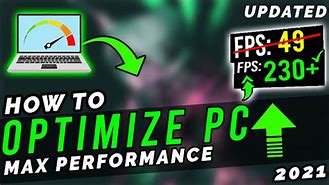How To Optimize Your Gaming PC For High FPS In 2024
In the realm of gaming, achieving high frame rates (FPS) is a constant pursuit. A higher FPS translates to smoother gameplay, reduced lag, and an overall more immersive experience. Whether you’re a casual gamer or a hardcore enthusiast, optimizing your gaming PC for high FPS is essential for unlocking its full potential.
Understanding FPS & Its Impact On Gaming
FPS, short for frames per second, measures how many images a gaming PC can display per second. The higher the FPS, the smoother and more responsive the gameplay. For a seamless gaming experience, aim for at least 60 FPS, but 144Hz or even 240Hz monitors can take advantage of even higher frame rates.
Imagine trying to watch a movie with choppy, jerky movements. That’s what low FPS feels like in gaming. It can ruin the flow of the game, make it difficult to react to fast-paced action, and just overall be frustrating.
High FPS is crucial for:
- Competitive Gaming: For multiplayer games, high FPS can provide a significant advantage by enabling faster reaction times and quicker decision-making.
- Immersive Gameplay: Smooth, high-FPS gameplay makes gaming more immersive and enjoyable.
- Reducing Input Lag: A high refresh rate monitor paired with high FPS eliminates input lag, ensuring your actions are reflected on screen as quickly as possible.
The Essential Hardware Components for High FPS
To achieve high FPS, you need the right hardware components. Here are some key elements to consider:
1. The Graphics Processing Unit (GPU): The Heart of Your Gaming PC
The GPU is the powerhouse of your gaming PC, responsible for rendering the visuals on your screen. A powerful GPU is essential for high FPS, particularly for modern games with demanding graphics.
When choosing a GPU, look for:
- High-End Models: Consider flagship models from leading manufacturers like NVIDIA or AMD.
- Dedicated VRAM: The amount of video memory (VRAM) impacts how many textures and models the GPU can load simultaneously.
- Clock Speed and Cores: Higher clock speeds and more cores translate to better processing power.
2. The Central Processing Unit (CPU): The Brain of Your Gaming PC
The CPU handles all the calculations and processing tasks in your gaming PC. A powerful CPU can make a big difference in FPS, especially in games that utilize a lot of CPU power, such as strategy games or massively multiplayer online role-playing games (MMORPGs).
When selecting a CPU:
- Focus on Multi-Core Performance: Look for CPUs with a high number of cores, as this will improve performance in multi-threaded applications.
- Clock Speed: Higher clock speeds mean faster processing power.
- Cache Size: A larger cache size allows the CPU to access data more quickly.
3. The RAM: Your PC's Short-Term Memory
RAM, or random access memory, is where your PC temporarily stores data that is actively being used. A good amount of RAM can improve FPS, as it allows the CPU and GPU to access data more quickly.
When buying RAM:
- Higher Frequency: Look for RAM with a higher frequency, as this improves data transfer speeds.
- More Capacity: 16GB or more is recommended for gaming.
- Matching Sets: Buy two or four sticks of RAM with the same specifications.
Optimizing Your PC Settings for Maximum Performance
Once you have the right hardware, you can further boost your FPS by optimizing your PC settings. Here are some key adjustments:
1. Graphics Settings: Finding the Right Balance
The graphics settings in a game control its visual fidelity. Lowering these settings can drastically improve FPS, but at the expense of visual quality.
Experiment with different settings to find a balance between performance and visual fidelity:
- Resolution: Lowering the resolution can significantly increase FPS.
- Texture Quality: Reduce the texture quality to decrease the load on your GPU.
- Anti-Aliasing: Disable or lower the anti-aliasing level to smooth out jagged edges.
- Shadows and Lighting: Decrease shadow and lighting quality to improve FPS.
2. In-Game VSync: Eliminating Screen Tearing
VSync, short for vertical synchronization, helps prevent screen tearing by syncing the refresh rate of your monitor with the game’s FPS. However, VSync can cause input lag, especially when the game’s FPS exceeds your monitor’s refresh rate.
Consider these options:
- Disable VSync: If your FPS is consistently above your monitor’s refresh rate, disabling VSync can eliminate input lag.
- Enable VSync: If your FPS is lower than your monitor’s refresh rate, enable VSync to prevent screen tearing.
- Use Adaptive VSync: This setting allows VSync to automatically enable or disable based on your game’s FPS, providing the best of both worlds.
The Power of Overclocking: Unleashing Your Hardware's Potential
Overclocking involves pushing your hardware components beyond their factory-specified limits. This can significantly boost FPS, but it comes with the risk of instability and component damage.
Before you overclock:
- Research: Learn about the risks and safety measures involved.
- Use Reputable Software: Use reliable overclocking software like MSI Afterburner or EVGA Precision X1.
- Monitor Temperatures: Keep a close eye on your CPU and GPU temperatures to avoid overheating.
1. Overclocking Your CPU
Overclocking your CPU can improve its processing power and boost FPS in CPU-intensive games.
To overclock your CPU:
- Increase the CPU’s Clock Speed: Incrementally increase the clock speed until you reach a stable overclock.
- Adjust Voltage: You may need to increase the voltage to keep the CPU stable at a higher clock speed.
- Test Performance: Run benchmarks to assess the performance gain.
2. Overclocking Your GPU
Overclocking your GPU can significantly enhance its performance and increase FPS in demanding games.
To overclock your GPU:
- Increase the Core Clock Speed: Gradually increase the core clock speed until you find a stable overclock.
- Adjust Memory Clock: Increase the memory clock speed to improve data transfer rates.
- Monitor Temperatures: Ensure your GPU doesn’t overheat.
Mastering Graphics Drivers: Keeping Your PC Up-to-Date
Graphics drivers are software that enable communication between your GPU and the games you play. Installing the latest graphics drivers can often significantly boost FPS and improve performance.
Here’s how to keep your drivers up-to-date:
- Visit the Manufacturer’s Website: Download the latest drivers from NVIDIA or AMD.
- Use Driver Update Software: Use software like Driver Booster to automatically download and install new drivers.
Minimizing System Load: Closing Unnecessary Background Processes
Background processes can consume system resources and reduce FPS. Close any unnecessary programs and services running in the background.
Here are some tips to minimize system load:
- Disable Startup Programs: Prevent programs from automatically launching at startup.
- Close Unnecessary Programs: Exit applications you aren’t using.
- Disable Background Services: Disable any services that aren’t essential.
Exploring Advanced Techniques: Using Game Optimization Tools and Tweaks
Beyond the basic optimization techniques, you can delve into advanced techniques for even greater FPS gains.
1. Game Optimization Tools:
Several third-party game optimization tools can help you tweak your PC settings for maximum performance.
Popular game optimization tools include:
- Razer Cortex: Offers one-click game optimization, boosting FPS by automatically adjusting settings and closing unnecessary processes.
- IObit Game Booster: Similar to Razer Cortex, Game Booster can optimize your PC and increase FPS for a smoother gaming experience.
- Nvidia GeForce Experience: Offers game optimization profiles that automatically adjust settings for optimal performance.
2. Game Tweaks:
Many games have specific settings and tweaks that can significantly improve FPS.
Here are some common tweaks:
- Disable In-Game Features: Turn off any unnecessary in-game features, like shadows, anti-aliasing, or particle effects.
- Change Resolution Scaling: Use a lower resolution scaling to reduce the load on your GPU.
- Tweak Graphics Settings: Experiment with different graphics settings to find the optimal balance between performance and visual fidelity.
The Importance of Proper Cooling for Consistent Performance
Overheating can severely impact FPS and stability. Ensure your PC has adequate cooling to prevent this.
Here are some ways to improve cooling:
- Ensure Proper Airflow: Make sure your PC case has good airflow, with fans strategically placed to circulate air.
- Clean Your PC Regularly: Dust buildup can impede airflow and increase temperatures.
- Apply Thermal Paste: Apply a thin layer of thermal paste between your CPU and cooler to improve heat transfer.
Building a Powerful Gaming PC: A Guide to Choosing the Right Components
If you’re building a new gaming PC, choosing the right components is crucial for achieving high FPS.
Here’s a comprehensive guide to selecting the best components:
- Motherboard: Choose a motherboard that supports the latest CPUs and GPUs, and has enough expansion slots for future upgrades.
- CPU: Select a powerful CPU with multiple cores and high clock speeds.
- GPU: Choose a high-end GPU with dedicated VRAM, a high core count, and a fast clock speed.
- RAM: Choose a high-frequency RAM with at least 16GB of capacity.
- Storage: Use an SSD for fast boot times and game loading.
- Power Supply: Choose a PSU with enough wattage to power all your components.
- Case: Select a case with good airflow and enough space for your components.
Future-Proofing Your PC for Long-Term FPS Gains
As new games are released and technology advances, your PC’s performance can degrade over time. To future-proof your PC for high FPS, consider these strategies:
- Invest in Future-Proof Components: Choose components with future-proof capabilities, such as a motherboard that supports the latest CPUs and a GPU with ample VRAM.
- Upgrade Regularly: Periodically upgrade your PC components, especially the GPU, to keep up with demanding new games.
- Stay Informed: Stay informed about the latest gaming technology and optimization techniques.
Conclusion
By implementing these strategies and staying informed about the latest technologies, you can ensure your gaming PC is consistently delivering high FPS and an exceptional gaming experience. Remember, optimizing your PC is an ongoing process, so always be prepared to adjust your settings and experiment with new techniques as your hardware evolves and new games are released.
Get out there and start optimizing your PC for those glorious high frame rates. You’ll thank yourself later!
FAQ:
1. What is the minimum FPS I should aim for?
For a smooth and enjoyable gaming experience, aim for at least 60 FPS.
2. Is a high-end GPU always necessary for high FPS?
While a powerful GPU is essential for demanding games, you can achieve high FPS in less demanding games with a mid-range GPU.
3. Can overclocking damage my PC components?
Yes, overclocking can damage your components if not done properly. Always monitor temperatures and proceed with caution.
4. How often should I update my graphics drivers?
It’s a good idea to update your graphics drivers every few weeks or whenever a new version is released.
5. What are some of the best game optimization tools?
Popular game optimization tools include Razer Cortex, IObit Game Booster, and Nvidia GeForce Experience.

